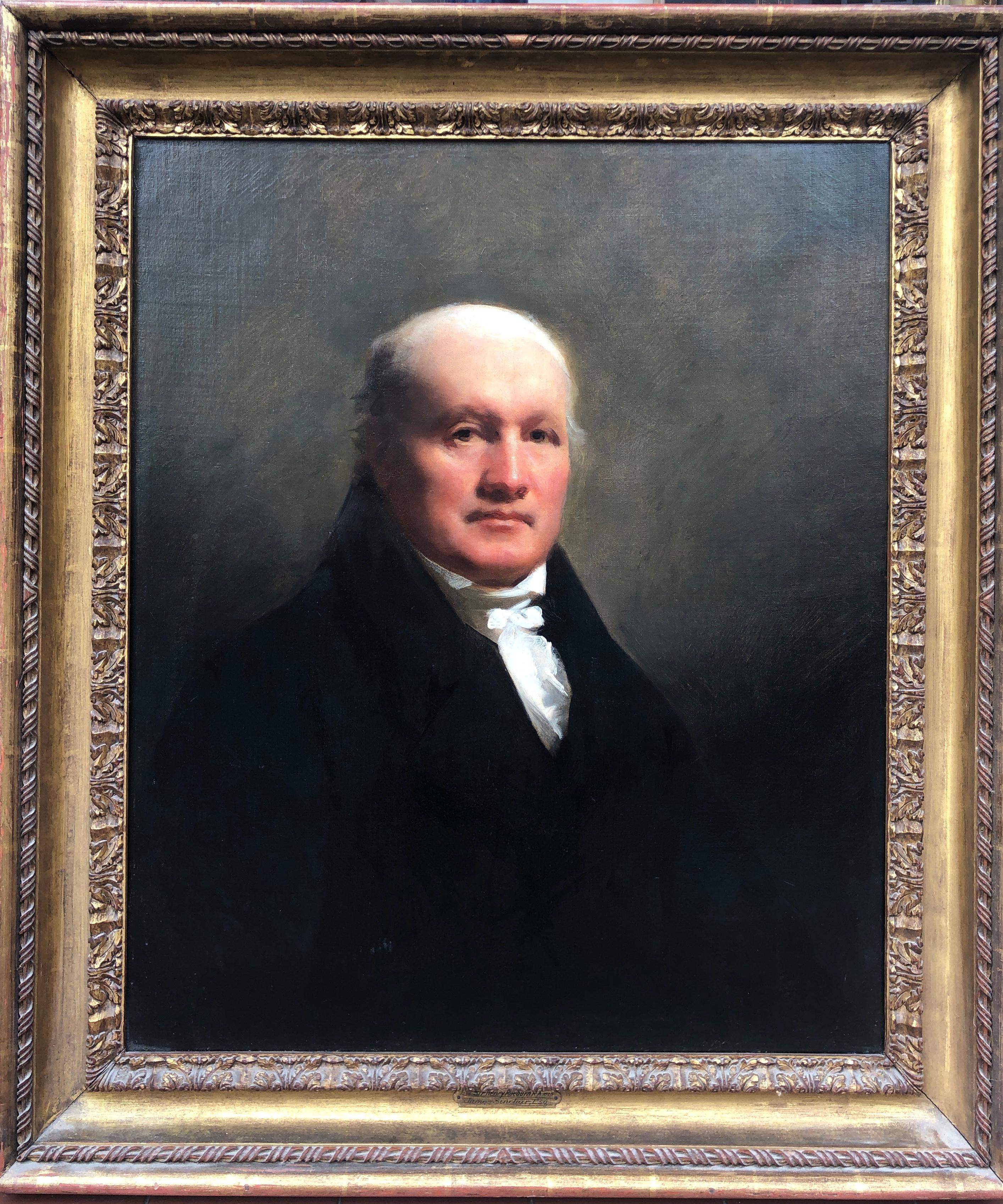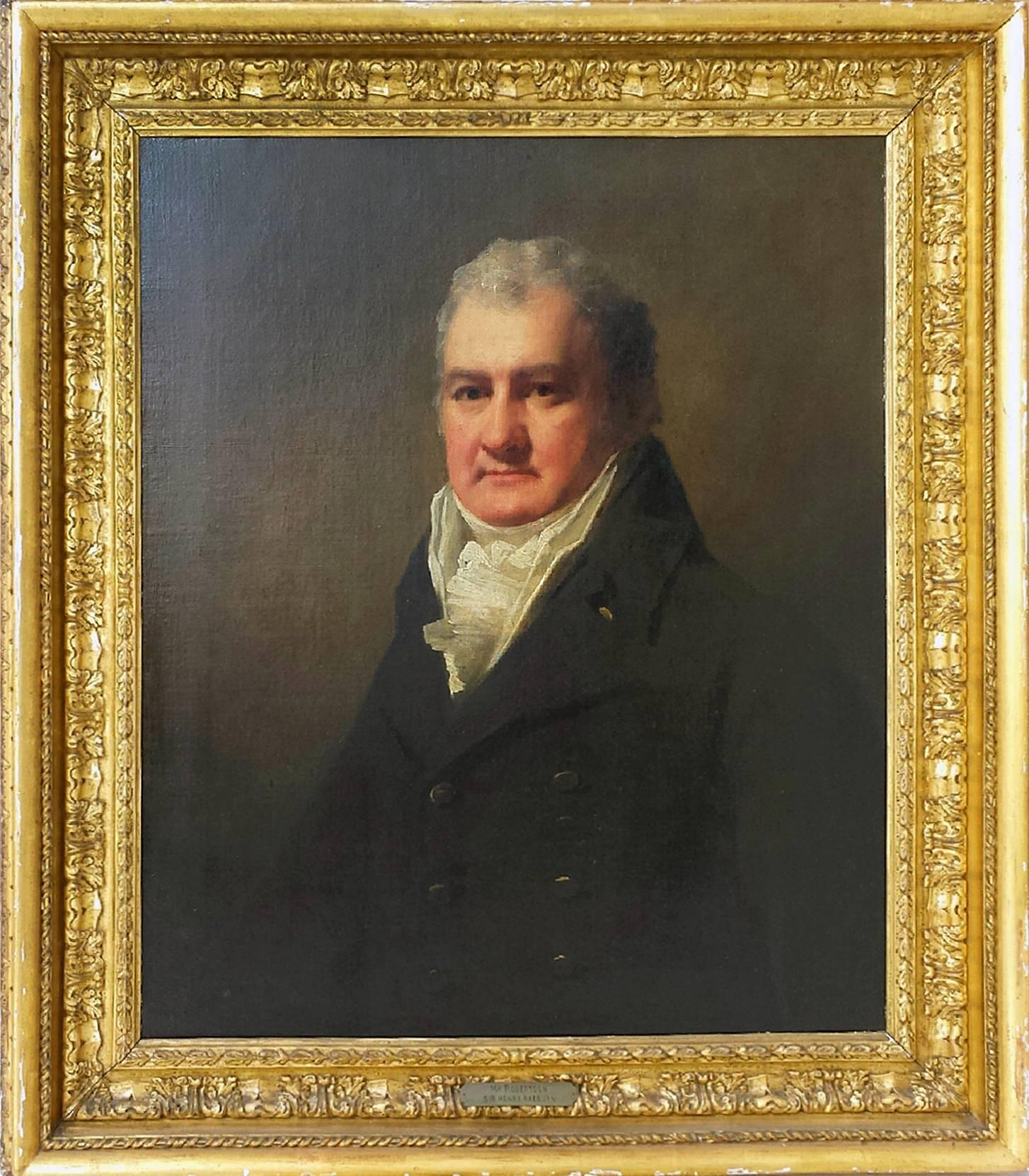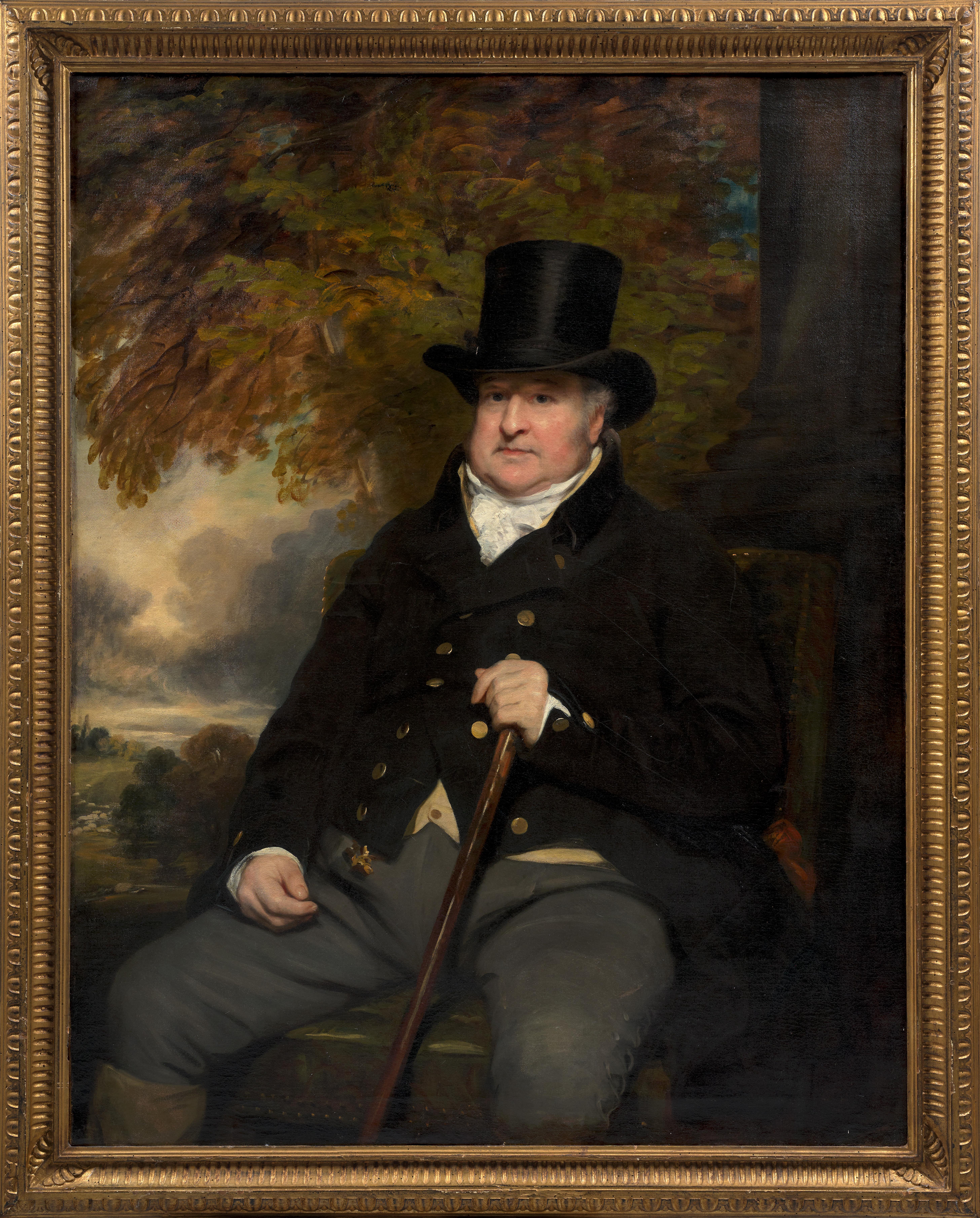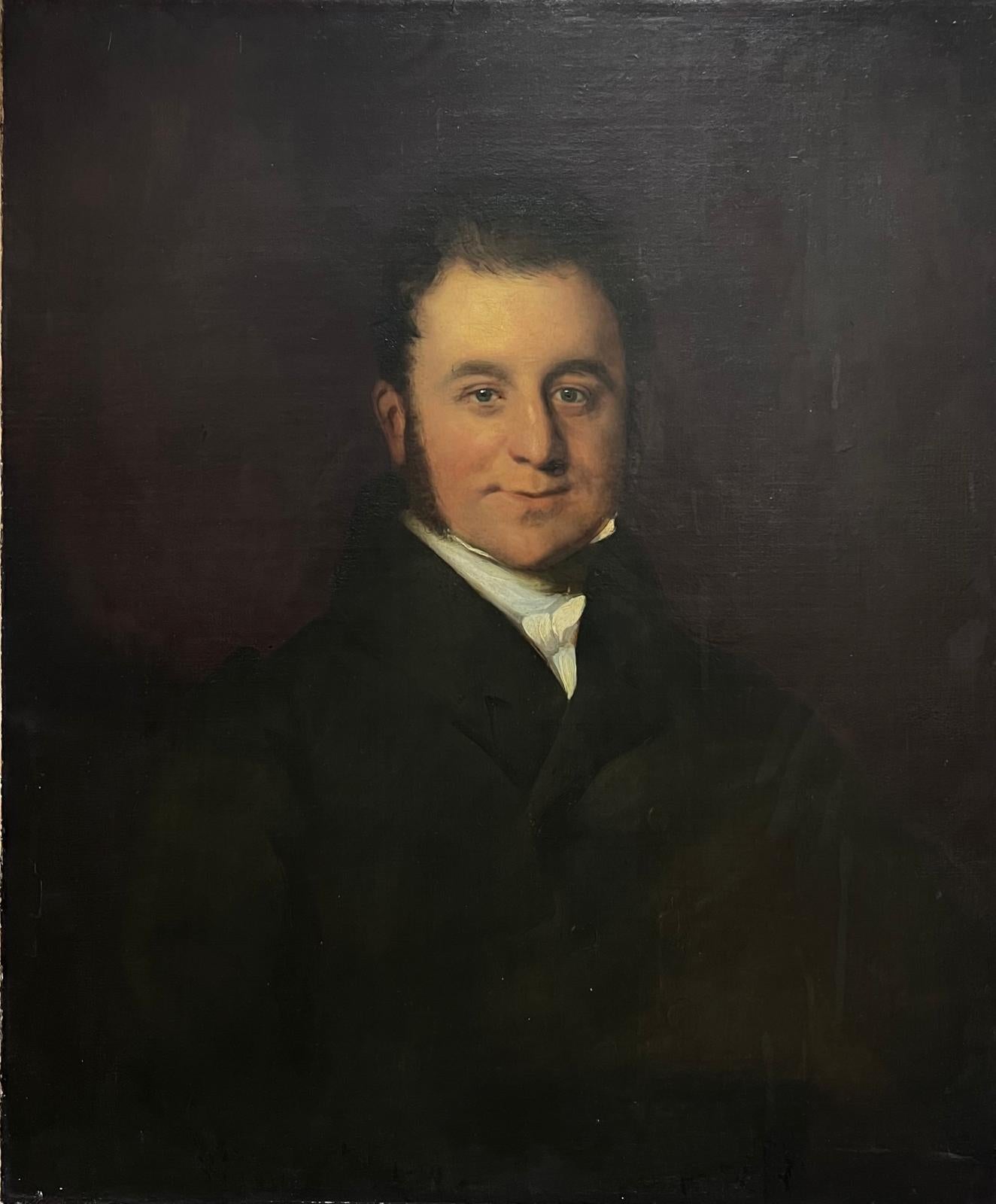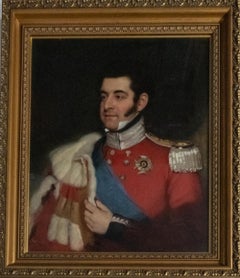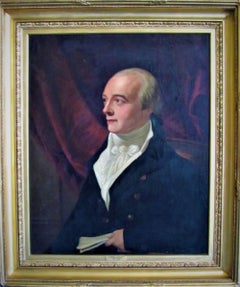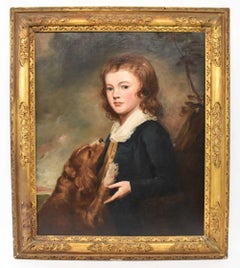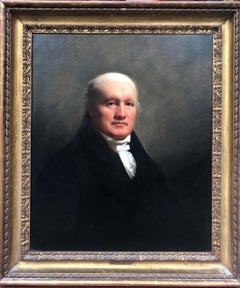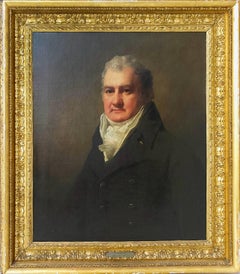Items Similar to Henry Raeburn, (circle) 19th Century portrait of Sir Charles Forbes Edinglassie
Want more images or videos?
Request additional images or videos from the seller
1 of 8
Henry Raeburn, (circle) 19th Century portrait of Sir Charles Forbes Edinglassie19th century
19th century
$5,507.55
$8,264.7733% Off
£3,995
£5,99533% Off
€4,665.14
€7,000.6433% Off
CA$7,615.17
CA$11,427.5233% Off
A$8,360.51
A$12,545.9933% Off
CHF 4,361.69
CHF 6,545.2733% Off
MX$101,173.78
MX$151,823.9933% Off
NOK 54,667.07
NOK 82,034.8233% Off
SEK 51,510.76
SEK 77,298.3733% Off
DKK 34,824.06
DKK 52,257.8833% Off
About the Item
Portrait of Sir Charles Forbes of Edinglassie, Oil on canvas.
The size of the portrait is 75 cm x 59.5 cm whilst overall the size is 106 cm x 91 cm
In very good condition.There has been some restoration/overpainting etc.There is some minor craquelure.
Housed in a period gilt frame decorated with acorns and leaves
Overall a good portrait, circle of a fine scottish artist (unsigned) , with an interesting sitter, his details below.
sir Charles Forbes of Edinglassie
Sir Charles Forbes, 1st Baronet (1774–1849) was a Scottish politician, of Newe and Edinglassie, Aberdeenshire. Forbes was the son of the Rev. George Forbes of Lochell. He was a descendant of Alexander Forbes of Kinaldie and Pitsligo, and was in 1833 served heir male in general to Alexander Forbes, 3rd lord Forbes of Pitsligo, father of Alexander Forbes, 4th Lord Forbes of Pitsligo, attainted in 1745.
Forbes was of a bluff but kindly nature, diffident as to his own merits, of a straightforward and manly character. On the death of his uncle in 1821 Forbes succeeded to the entailed estates of the Forbeses of Newe, and was created a baronet by patent in 1823.[1] He married in 1811. His daughter, Elizabeth, married General, Lord James Hay, second son of the seventh Marquess of Tweeddale.
Sir Henry Raeburn FRSE, RA, RSA (1756-1823)
Scottish portrait painter and Scotland's first significant portrait painter
since the Union to remain based in Scotland.
He served as Portrait Painter to King George IV in Scotland
Raeburn had all the essential qualities of a popular and successful portrait painter.
He was able to produce a telling and forcible likeness;
his work is distinguished by powerful characterisation,
stark realism, dramatic and unusual lighting effects
Free insured delivery, usually within 14 working days
We ship worldwide free however all customs/taxes payable by purchaser
- Creation Year:19th century
- Dimensions:Height: 41.74 in (106 cm)Width: 35.83 in (91 cm)Depth: 2.37 in (6 cm)
- Medium:
- Movement & Style:
- Circle Of:Henry Raeburn (circle) (1756 - 1823, British)
- Period:
- Condition:
- Gallery Location:York, GB
- Reference Number:1stDibs: LU180029916992
About the Seller
5.0
Vetted Professional Seller
Every seller passes strict standards for authenticity and reliability
Established in 1991
1stDibs seller since 2022
24 sales on 1stDibs
Typical response time: 15 hours
- ShippingRetrieving quote...Shipping from: York, United Kingdom
- Return Policy
Authenticity Guarantee
In the unlikely event there’s an issue with an item’s authenticity, contact us within 1 year for a full refund. DetailsMoney-Back Guarantee
If your item is not as described, is damaged in transit, or does not arrive, contact us within 7 days for a full refund. Details24-Hour Cancellation
You have a 24-hour grace period in which to reconsider your purchase, with no questions asked.Vetted Professional Sellers
Our world-class sellers must adhere to strict standards for service and quality, maintaining the integrity of our listings.Price-Match Guarantee
If you find that a seller listed the same item for a lower price elsewhere, we’ll match it.Trusted Global Delivery
Our best-in-class carrier network provides specialized shipping options worldwide, including custom delivery.More From This Seller
View All19th century portrait military officer 5th Royal Lancashire Militia, East Lancs
Located in York, GB
A fine 19th century oil on canvas portrait stated to be Captain Paul John Henry Butler, 5th Royal Lancashire Militia, half length, wearing breast star. Hou...
Category
19th Century Realist Portrait Paintings
Materials
Oil
19th century Portrait Spencer Perceval Attributed To George Francis joseph
By George Francis Joseph
Located in York, GB
A late 18th early 19th century oil on canvas Portrait of Prime Minister Spencer Perceval, bust-length, in an interior, holding papers.Attributed to George Francis Joseph...
Category
19th Century Old Masters Portrait Paintings
Materials
Oil
19th century Portrait Of A Young Man, Oil, Circle Of Thomas Jones Barker
Located in York, GB
Portrait of a young man,
half length wearing a yellow waistcoat and holding a cane , Circle of Thomas Jones Barker (1815-1882),(unsigned)
Oil on canvas, h...
Category
19th Century Realist Portrait Paintings
Materials
Oil
GEORGE ROMNEY(after)19th century portrait The Hon.Reverend Anchitel Grey as a Bo
By George Romney
Located in York, GB
A fine painting after George Romney of The Hon.Reverend Anchitel Grey (1774 – 1833) as a Boy
The painting depicts a boy aged about ten, standing, turned to the left, gazing at the spectator, wearing a blue coat, and white linen collar, a spaniel with its paws on his chest. Shoulder length brown hair. Trees in the background on the right, distant horizon with cloudy sky on the left.
The sitter was the third son of George Harry Grey, 5th Earl of Stamford (1765-1845) and Lady Henrietta Cavendish-Bentinck (died 4th June 1827), daughter of the 2nd Duke of Portland...
Category
19th Century Old Masters Portrait Paintings
Materials
Oil
19th century English School Portrait of a Gentleman, with Riding Crop & Dog
Located in York, GB
(early 19th century) unsigned English School Portrait of a Young Gentleman, with Riding Crop and Dog
The reverse stamped T Brown, High Holborn, Linen, oil on canvas,
The size overall being 104 cm x 84 cm whilst the painting is 89cm x 70cm
A charming portrait in overall very good condition housed in a gilt frame
The painting has been cleaned recently . There is some old restoration in the form of a small patch to the rear,barely visible to the front. some texturization to top right in certain light
Certainly does not detract from this charming painting
SHIPPING
Free uk delivery
Delivery usually within 14 working days.Fully insured delivery.
please provide telephone/email details for courier.
We ship worldwide for free. All taxes/customs etc to be paid for by purchaser.
RETURNS (The Consumer Contracts Regulations) Whilst we are sure that you will be extremely happy with your purchase,
if for any reason you are not, then you are entitled to return the item to us for a refund.
For all purchases made
you are entitled to return the item(s) for a period of up to 14 days
following receipt by you or a representative indicated by you.
Please contact us to confirm that you are returning the item(s)
and the reason for doing so.
Upon receipt of the item(s) we will refund the purchase price via your original payment method...
Category
Early 19th Century Old Masters Portrait Paintings
Materials
Oil
$3,860 Sale Price
20% Off
Free Shipping
Portrait Of A Gentleman George Williams Kenworthy by John Dalziel Kenworthy
Located in York, GB
John Dalziel Kenworthy portrait of a gentleman . Fine, large and imposing oil on canvas housed in a gilt frame.
The sitter is unidentified, he has an aristocratic and characterful lo...
Category
Early 1900s Old Masters Portrait Paintings
Materials
Oil
You May Also Like
Striking 18th Century Portrait of the 12th Earl of Caithness
By Sir Henry Raeburn
Located in London, GB
Sir Henry Raeburn (1756-1823)
James Sinclair, 12th Earl of Caithness (1766-1823)
Oil on Canvas
30 X 25 inches Unframed
37 X 32 inches framed
Sir Henry Raeburn FRSE RA RSA (4 March 1756 – 8 July 1823) was a Scottish portrait painter and Scotland's first significant portrait painter since the Union to remain based in Scotland. He served as Portrait Painter to King George IV in Scotland.
Raeburn was born the son of a manufacturer in Stockbridge, on the Water of Leith: a former village now within the city of Edinburgh. He had an older brother, born in 1744, called William Raeburn. His ancestors were believed to have been soldiers, and may have taken the name "Raeburn" from a hill farm in Annandale, held by Sir Walter Scott's family. Orphaned, he was supported by William and placed in Heriot's Hospital, where he received an education. At the age of fifteen he was apprenticed to the goldsmith James Gilliland of Edinburgh, and various pieces of jewellery, mourning rings and the like, adorned with minute drawings on ivory by his hand, still exist. Soon he took to the production of carefully finished portrait miniatures; meeting with success and patronage, he extended his practice to oil painting, at which he was self-taught. Gilliland watched the progress of his pupil with interest, and introduced him to David Martin, who had been the favourite assistant of Allan Ramsay the Latter, and was now the leading portrait painter in Edinburgh. Raeburn was especially aided by the loan of portraits to copy. Soon he had gained sufficient skill to make him decide to devote himself exclusively to painting. George Chalmers (1776; Dunfermline Town Hall) is his earliest known portrait.
In his early twenties, Raeburn was asked to paint the portrait of a young lady he had noticed when he was sketching from nature in the fields. Ann was the daughter of Peter Edgar of Bridgelands, and widow of Count James Leslie of Deanhaugh. Fascinated by the handsome and intellectual young artist, she became his wife within a month, bringing him an ample fortune. The acquisition of wealth did not affect his enthusiasm or his industry, but spurred him on to acquire a thorough knowledge of his craft. It was usual for artists to visit Italy, and Raeburn set off with his wife. In London he was kindly received by Sir Joshua Reynolds, the president of the Royal Academy, who advised him on what to study in Rome, especially recommending the works of Michelangelo, and gave Raeburn letters of introduction for Italy. In Rome he met his fellow Scot Gavin Hamilton, Pompeo Girolamo Batoni and Byers, an antique dealer whose advice proved particularly useful, especially the recommendation that "he should never copy an object from memory, but, from the principal figure to the minutest accessory, have it placed before him." After two years of study in Italy he returned to Edinburgh in 1787, and began a successful career as a portrait painter. In that year he executed a seated portrait of the second Lord President Dundas.
Examples of his earlier portraiture include a bust of Mrs Johnstone of Baldovie and a three-quarter-length of Dr James Hutton: works which, if somewhat timid and tentative in handling and not as confident as his later work, nevertheless have delicacy and character. The portraits of John Clerk, Lord Eldin, and of Principal Hill of St Andrews belong to a later period. Raeburn was fortunate in the time in which he practised portraiture. Sir Walter Scott, Hugh Blair, Henry Mackenzie, Lord Woodhouselee, William Robertson, John Home, Robert Fergusson, and Dugald Stewart were resident in Edinburgh, and were all painted by Raeburn. Mature works include his own portrait and that of the Rev. Sir Henry Moncrieff Wellwood, a bust of Dr Wardrop of Torbane Hill, two full-lengths of Adam Rolland of Gask, the remarkable paintings of Lord Newton and Dr Alexander Adam in the National Gallery of Scotland, and that of William Macdonald of St Martin's. Apart from himself, Raeburn painted only two artists, one of whom was Sir Francis Leggatt Chantrey, the most important and famous British sculptor of the first half of the 19th century. It has recently been revealed that Raeburn and Chantrey were close friends and that Raeburn took exceptional care over the execution of his portrait of the sculptor, one of the painter's mature bust-length masterpieces.
It was commonly believed that Raeburn was less successful in painting female portraits, but the exquisite full-length of his wife, the smaller likeness of Mrs R. Scott Moncrieff in the National Gallery of Scotland, and that of Mrs Robert Bell, and others, argue against this. Raeburn spent his life in Edinburgh, rarely visiting London, and then only for brief periods, thus preserving his individuality. Although he, personally, may have lost advantages resulting from closer association with the leaders of English art, and from contact with a wider public, Scottish art gained much from his disinclination to leave his native land. He became the acknowledged chief of the school which was growing up in Scotland during the early 19th century, and his example and influence at a critical period were of major importance. So varied were his other interests that sitters used to say of him, "You would never take him for a painter till he seizes the brush and palette."
In 1812 he was elected president of the Society of Artists in Edinburgh; and in 1814 associate, and in the following year full member, of the Royal Scottish Academy. On 29 August 1822 he was knighted by George IV and appointed His Majesty's limner for Scotland at the Earl of Hopetoun house. He died in Edinburgh.
Raeburn had all the essential qualities of a popular and successful portrait painter. He was able to produce a telling and forcible likeness; his work is distinguished by powerful characterisation, stark realism, dramatic and unusual lighting effects, and swift and broad handling of the most resolute sort. David Wilkie recorded that, while travelling in Spain and studying the works of Diego Velázquez, the brushwork reminded him constantly of the "square touch" of Raeburn. Scottish physician and writer John Brown wrote that Raeburn "never fails in giving a likeness at once vivid, unmistakable and pleasing. He paints the truth, and he paints it with love".
Raeburn has been described as a "famously intuitive"portrait painter. He was unusual amongst many of his contemporaries, such as Reynolds, in the extent of his philosophy of painting directly from life; he made no preliminary sketches. This attitude partly explains the often coarse modelling and clashing colour combinations he employed, in contrast to the more refined style of Thomas Gainsborough and Reynolds. However these qualities and those mentioned above anticipate many of the later developments in painting of the 19th century from romanticism to Impressionism.
Sir Henry Raeburn died in St Bernard's House (17 St Bernards Crescent), Stockbridge, Edinburgh. He is buried in St. Cuthbert's churchyard against the east wall (the monument erected by Raeburn in advance) but also has a secondary memorial in the Church of St John the Evangelist, Edinburgh.
James Sinclair, 12th Earl of Caithness was born at Barrogill Castle (Castle of Mey) on 31 May 1766. He was the son of Sir John Sinclair of Mey, Baronet who he succeeded in the baronetcy in 1774. He succeeded as 12th earl of Caithness in 1789.
He was lord-lieutenant of the county of Caithness and lieutenant-colonel of the Ross-shire militia.
He married at Thurso Castle on 2 January 1784 Jane, second daughter of Alexander Campbell...
Category
18th Century Portrait Paintings
Materials
Oil
$29,778 Sale Price
40% Off
Free Shipping
Half Length Portrait of Mr. Robertson of Edinburgh
By Sir Henry Raeburn
Located in Miami, FL
Half Length Portrait of Mr. Robertson
Sir. Henry Raeburn ( Scottish 1756 - 1823 )
Half Length Portrait of Mr. Robertson
29x 24
Purchased, J Leger & Son,...
Category
18th Century Realist Portrait Paintings
Materials
Oil
19th Century by Sir Henry Raeburn Portrait of a landowner Oil on canvas
By Sir Henry Raeburn
Located in Milano, Lombardia
Sir Henry Raeburn (Stockbridge, Edinburgh, UK, 1756 - Edinburgh, UK, 1823)
Title: Portrait of a landowner
Year: Early 19th century, 1803
Medium: Oil on canvas
Dimensions: Without fra...
Category
Early 19th Century Old Masters Portrait Paintings
Materials
Oil, Canvas
Lady Eleanor Dundas - Old Master 18C Scottish art oil painting female portrait
By Henry Raeburn (circle)
Located in Hagley, England
A fine large and stunning Scottish Old Master portrait oil painting on canvas portrait in good condition which depicts Lady Eleanor Dundas in a white dress set against an open landsc...
Category
19th Century Old Masters Portrait Paintings
Materials
Oil
Portrait of a Seated Gentleman - British 19th century art portrait oil painting
By Thomas Lawrence (circle)
Located in Hagley, England
This striking British 19th century portrait oil painting is attributed to the circle of Sir Thomas Lawrence. Painted circa 1820 it is the portrait of a seated gentleman in a brown hi...
Category
Early 19th Century Realist Portrait Paintings
Materials
Oil
1830's British Oil Painting Large Portrait of a Distinguished Gentleman
Located in Cirencester, Gloucestershire
Portrait of an English Gentleman
English School, circa 1830's period
oil on canvas, unframed
Canvas: 30 x 24.5 inches
Provenance: Private collection, UK
Condition: relined canvas, ov...
Category
Early 19th Century English School Portrait Paintings
Materials
Oil, Canvas
More Ways To Browse
19th Century Male Oil Paintings
Acorn Frame
David Anthony Tauszky
David Pallock
David Pollack
Dior Sign Display
Dorit Levi
Douglas Swainson
Duke Of Wellington Portrait
E Larsen Painting
Eduardo Forlenza
Edward Russell
Elizabethan Oil Portrait
Emile Marin
Fernando Ramos Prida
Frosty The Snowman Vintage
Gaspare Landi
George Allan Art
